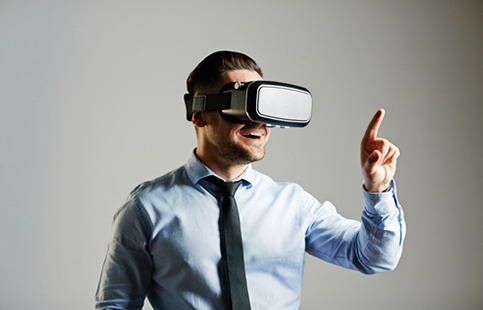2021-12-14
As the concept of "meta universe" spreads all over the world, players from all walks of life have increased their firepower, aiming to seize the commanding heights of development. AR/VR/MR, etc., as an important port to connect to the metaverse, are naturally the strengths of related manufacturers. As the carrier of AR/VR/MR equipment content presentation and dissemination, display screens have also become a source of gold for display industry chain manufacturers. The focus is on micro display technologies such as Micro LED and Micro OLED.
In terms of brands, Meta (Facebook), Apple, Sony, TCL, Xiaomi, Vuzix, etc. are actively researching and developing AR/VR/MR devices; in the display industry chain, the number of players is growing rapidly in materials, chips, packaging, modules, and displays. , The development progress is also accelerating.
As far as Micro LED-equipped devices are concerned, in recent months, there have been frequent major moves in the Micro LED AR field, such as the chip side. In November, Nanjing Xinshiyuan released its own Micro LED chip for AR/VR and launched a B+ round of strategic financing to increase its investment in the field of microdisplay chips under the Universe; in the same month, JBD announced the completion of its second financing of several hundred million yuan , To invest in the R&D and mass production of Micro LED micro-display chips in the AR application field.
Recently, Raysolve has also completed a tens of millions of US dollars in Pre-A round of financing. The funds will be used for the research and development iteration and small batch production of full-color Micro LED micro-display chips, and also aiming at the business opportunities of Meta Universe.
 Image source: Photo Gallery
Image source: Photo Gallery
According to 36Kr news, Radium Semiconductor’s current round of financing was led by Gaorong Capital, followed by Yaotu Capital, and Taihe Capital served as the exclusive financial adviser. Within half a year, Radium Semiconductor has completed two rounds of angel round and Pre-A round of financing, and has received a total of nearly 100 million yuan in investment.
It is understood that Leiyu Semiconductor is mainly engaged in Micro LED micro-display chip architecture design, process and monolithic full-color technology research. The company’s founder and CEO Zhuang Yongzhang believes that to achieve AR consumer-level applications, single-chip full-color is the threshold that must be crossed for the current development of Micro LED micro-displays.
Technically, Leiyu Semiconductor mainly adopts the monolithic integration process of semiconductor technology, and realizes the miniaturization of pixel size and pixel pitch through the design and process of micro-display devices on the CMOS drive wafer. At the same time, Laiyu Semiconductor uses large-size epitaxial transfer technology to ensure ultra-high pixel density and high mass production, while also enabling chips with higher performance and lower power consumption.
Specifically, Leiyu Semiconductor adopts a unique common anode (CoANODETM) ultra-high-brightness Micro LED chip architecture, combined with large-size silicon-based GaN epitaxial wafers and color coatings to prepare full-color Micro LED micro-display chips. Meet the display requirements of small-size, high-brightness interactive application scenarios such as AR smart glasses.
In 2019, Radium Semiconductor released the world's first single-chip full-color Micro LED micro-display chip in Silicon Valley. After the completion of this round of financing, Leiyu Semiconductor will continue to increase its R&D investment in full-color Micro LED micro-display technology, and it is expected to complete small-volume mass production shipments in the first half of 2022. In the future, Radium Semiconductor's products will also be used in different fields such as HUD (automobile head-up display), 3D printing, and plateless lithography.
According to LEDinside, the US Micro LED solution provider Compound Photonics (CP) also adopts the same technical route. The company’s proprietary Micro LED integration technology is a monolithic integration of GaN-based Micro LED array epitaxial wafers and advanced CMOS backplane array wafers, combined with its high-performance IntelliPix Micro LED micro-display backplane drive technology to achieve full RGB Color Micro LED display. Currently, CP is also accelerating the development of Micro LED displays for AR.
Although there are many layouts, it is not difficult to find that the development of Micro LED display technology has not yet entered the stage of mass production. In particular, Micro LED chips still face many difficulties in efficiency, mass transfer, and full color. It has become an obstacle to the commercialization of AR equipment.
However, from the recent financing progress and product development progress of related companies, it can be seen that companies and the capital market are full of confidence in the development prospects of Micro LED in the field of smart devices such as AR/VR. In the future, under the conditions of simultaneous improvement of financial strength and technical strength, Micro LED chip manufacturers are expected to break through the technical bottlenecks of meta-universe physical layer interaction and help realize high-brightness, thin and full-color consumer AR/VR/MR smart device.
According to TrendForce's analysis, Metaverse will promote more manufacturers to invest in the construction of the virtual world. The fields of community communication, game entertainment, content creation, virtual economy and industrial applications will all be the focus of development in recent years. In addition to the improvement of semiconductor computing performance and the expansion of low-latency high-speed network coverage, the popularization of VR/AR devices used on the client side will also become the key to the development of the Metaverse industry. Therefore, TrendForce forecasts that global VR/AR device shipments will increase to 12.02 million units in 2022, with an annual growth rate of 26.4%. (LEDinside)